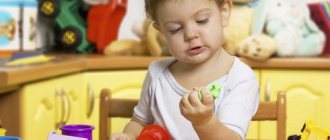Card index of games for the development of fine motor skills
On the table, all the rings are laid out evenly, in increasing sizes to the right of the pyramid. Then the pyramid is assembled in the appropriate order.
Card No. 9
"Search for objects in a bowl of cereal"
Tasks:
Children find it extremely pleasant to tinker, dig through a large amount of homogeneous material, passing grain or sand through their fingers, looking for pebbles or small toys hidden in it. This is beneficial for their psyche, the kids calm down, focus on finding surprises and learn to concentrate and be careful. Develop tactile senses of the fingertips.
Material:
A deep, stable bowl filled with some kind of cereal; several small objects - toys, pebbles 9 objects must be changed periodically to maintain the child’s interest and curiosity).
Description of the game.
The teacher and the child bring the material to the table. We immerse our hands in the cereal and encourage the baby to do the same. “Suddenly” we find the hidden object and place it on the table. We ask the child to find the rest of the hidden objects. We show how you can hide an object back into the cereal by burying it. We focus the child's attention on special care - there should be no cereals on the table. If suddenly some of the cereal accidentally spills, you need to remove it with a table brush.
Card No. 10
"Tying and Untying Bows"
A classic exercise by Maria Montessori, the direct goal of which is to master the ability to tie and untie laces and bows. At the same time, the child learns precise finger movements, sequence of operations and is focused on each step of the work. In this context, tying and untying frames, as well as fastening buttons and buckles, indirectly prepare the child for mastering the writing process.
Material:
A wooden frame with two halves of fabric attached, connected by red and white bows. There are five bows in total.
How to work with the material
.
Unleashing
. The child begins to untie the top bow and always works from top to bottom. He takes the ends of the ribbon with both hands and stretches them to the sides. The top bow, and all the others behind it, are untied. Now we will pry up the knots with our index finger, starting from the top one, and moving forward we untie them too. We straighten the ends of the ribbon to the sides and fold back the halves of the fabric to mark that the bows and knots are completely untied.
Tying.
Connect the halves of the fabric to the center. Let's take the ends of the top braid and throw them in opposite directions. Index finger
Using your left hand, move the tape and form a large loop from it. With your right hand, wrap the other end of the tape around this loop clockwise and insert it into the hole. Stretch the ends of the tape to the sides. The knot is tied. We will also tie the remaining knots, moving from top to bottom. Now let's start tying the bows. We will do exactly the same as with knots, but we will make narrow loops from the ends of the ribbon, gathered towards the base of the bow. In this case, the second loop is carefully pulled out from under the first and the bow itself is aligned.
MAGAZINE Preschooler.RF
Club for developing children’s speech and strengthening fine motor skills “Talking Fingers”MKDOU "Novokhopersky kindergarten of general developmental type No. 3 "Sun" Educational program
Head: Elena Vladimirovna Purzikova, teacher. 2015-2016
Explanatory note
“The sources of children’s abilities and gifts are at their fingertips. From the fingers, figuratively speaking, come the finest streams that feed the source of creative thought.” V. A. Sukhomlinsky
The origins of children's abilities and talents are at their fingertips. Various hand actions and finger games stimulate the process of the child’s speech and mental development, since the development of the hand is closely related to the development of the child’s speech and thinking.
Fine motor skills of the hands also interact with such higher properties of consciousness as attention and thinking. The development of fine motor skills is also important because the child’s entire future life requires the use of precise, coordinated movements of the hands and fingers, which are necessary to dress, draw and write, as well as perform many different everyday and educational activities. A child at this age will benefit from hand exercises in the pre-speech period, and finger games accompanied by poetry will develop speech and listening skills. The preschooler will learn to understand the meaning of what he hears and grasp the rhythm of speech. Finger games create a favorable emotional background, develop the ability to imitate an adult, teach them to listen attentively and understand the meaning of speech, and increase the child’s speech activity. If a child performs exercises, accompanying them with short poetic lines, that is, his speech will become clearer, rhythmic, bright, and control over the movements performed will increase. The child’s memory develops as he learns to remember certain hand positions and sequences of movements. The child develops imagination and fantasy. Having mastered all the exercises. He can “tell” whole stories with his fingers. Typically, a child who has a high level of development of fine motor skills is able to reason logically, his memory, attention, and coherent speech are sufficiently developed. Children's activity based on interests "Talking Fingers" is aimed at developing and strengthening fine motor skills in children 3-5 years old. Classes include a variety of game exercises based on various lexical topics. The work uses materials of different textures (paper, cardboard, fabric of various textures, threads, cereals, buttons, etc.)
Children's activities based on interests are held once a week in the afternoon throughout the school year. Form of work: with subgroups.
Predicted results.
- Children's ability to work with paper;
- Use of figurative toys in theatrical games;
- Develop the ability to hold a pencil (handles will become more flexible and obedient);
- The ability of preschoolers to work independently and creatively;
- Mastering the necessary knowledge and skills in joint activities with teachers.
Purpose of the program:
Development and strengthening of fine motor skills in preschool children in games, exercises and various types of productive activities (drawing, modeling, design), understanding of speech, harmonious development of children.
Tasks:
The program offers solutions to educational, educational and developmental problems, taking into account the age and individual developmental characteristics of preschoolers.
Educational:
- formation of voluntary coordinated movements of the fingers, eyes, flexibility of the hands, rhythmicity development of tactile perception (tactile, skin sensitivity of the fingers)
- formation of practical skills
- teach various skills in working with paper and plasticine.
Educational:
- development of fine motor skills of fingers and hands
- improving hand movements
- development of cognitive mental processes: voluntary attention, logical thinking, visual and auditory perception, memory
- children's speech development.
Educational:
- cultivate moral qualities towards others (kindness, sense of camaraderie, etc.)
- educate and develop artistic taste
- cultivate perseverance and focus.
Pedagogical technologies that ensure the implementation of the educational process.
Pedagogical principles:
- principle of consistency (from simple to complex, from particular to general)
- the principle of a rich object-based play environment for sensory education of children
- the principle of the relationship between sensory, mental and physical development
- the principle of integration of educational, educational and developmental tasks
- the principle of ensuring active cognitive-sensory practice.
Methods and forms:
- Conversations are aimed at creating conditions: for developing the ability to listen, hear, see and notice, observe and perceive.
- Discussion helps develop the ability to speak and prove, and think logically.
- Organizing game situations helps: gain interaction experience, make decisions, take responsibility..
To develop hand motor skills in children's hobby classes, the following techniques are used:
- self-massage of hands;
- finger gymnastics and finger games;
- performing movements with small objects (mosaics, construction sets, cereals, small toys, counting sticks, buttons, beads)
- drawing (with fingers, plasticine, shading according to a pattern, painting, labyrinths) applique, origami.
Providing the program.
Personnel: teacher with higher education.
Material and technical:
To successfully implement the program, you need the following materials and tools:
- rubber toys
- beads, ribbons, bows, buttons, matches, sticks. lacing
- various materials: plastic (dough, plasticine), bulk (cereals, legumes, sand); foam rubber, cotton wool, cotton swabs.
- colored paper, album, markers, glue, pencils
- finger theater figures, etc.
- finger games index
- card index of artistic words (poems, riddles)
- music library (classical works, children's repertoire).
Methodological literature:
- Abramova L.P. “Bushies are lambs. Finger games" . – M.: Karapuz, 2003.
- Agayan G.G. “Visiting the sun. Finger games" . – M.: Karapuz, 2004.
- Agayan G.G. “We stomped, we stomped... Finger games . – M.: Karapuz, 2004.
- Bardysheva T.Yu. “I’ll gore, I’ll gore! Finger games" . – M.: Karapuz. 1999.
- Kislinskaya T. “Genius at your fingertips . - M.: "Genesis" , 2008.
- RazenkovaYu. A., Odinokova G.Yu. “Hey, palm! Finger games . – M.: Karapuz, 2004
- “Educational games with children under three years old” : A popular guide for parents and teachers / Comp. Galanova T.V. – Yaroslavl: Academy of Development, 2002.
- Yanushko E.A. “Speech therapy classes with non-speaking children 2-3 years old. Development of speech understanding // education and training of children with developmental disorders" . – 2004. – No. 6. – pp. 22 – 28.
- Magazine "Hoop" .
| Next > |




